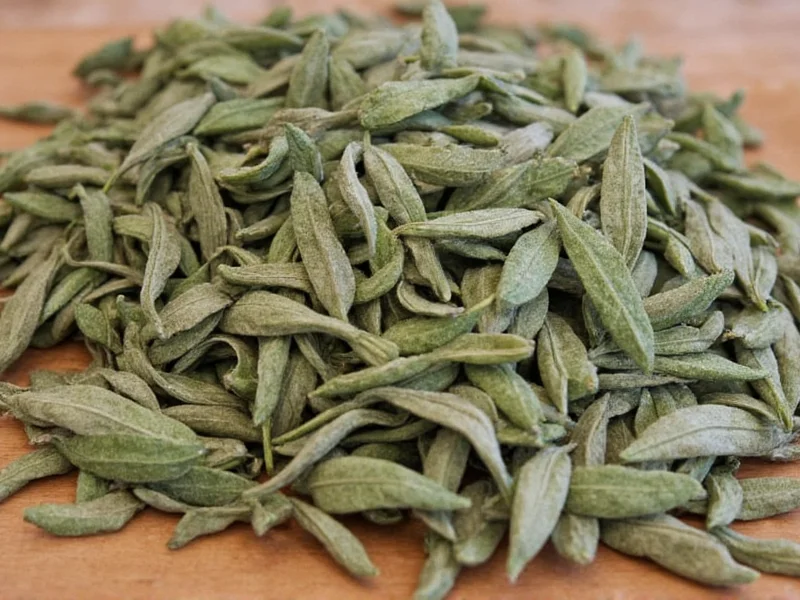1 teaspoon of dried sage equals 1 tablespoon of fresh sage. This 1:3 ratio accounts for dried sage's concentrated flavor due to moisture removal during the drying process. Understanding this conversion prevents over-seasoning and ensures balanced flavor in your dishes.
When cooking with herbs, knowing the proper dried to fresh conversion is essential for recipe success. Sage, with its earthy, slightly peppery flavor, is particularly potent when dried, making accurate measurement crucial. The standard conversion ratio—1 teaspoon dried sage equals 1 tablespoon fresh sage—exists because the drying process removes moisture while concentrating the essential oils and flavor compounds.
Why Dried and Fresh Sage Have Different Potencies
Fresh sage contains approximately 85% water, while dried sage has most of this moisture removed. This concentration effect means dried herbs generally have three to four times the flavor intensity of their fresh counterparts. Sage, being a hardy perennial herb with robust essential oils, follows this pattern closely, hence the 1:3 conversion ratio.
Using the wrong form without proper conversion can dramatically alter your dish. Too much dried sage can make foods bitter and overpowering, while insufficient fresh sage might leave dishes lacking that distinctive earthy note essential in recipes like Thanksgiving stuffing, sausage fillings, or brown butter sauces.
Dried Sage to Fresh Conversion Chart
| Dried Sage | Fresh Sage Equivalent | Best Used For |
|---|---|---|
| ¼ teaspoon | ¾ teaspoon | Delicate sauces, egg dishes|
| ½ teaspoon | 1½ teaspoons | Soups, stews, moderate seasoning|
| 1 teaspoon | 1 tablespoon | Standard conversion for most recipes|
| 1½ teaspoons | 4½ teaspoons | Heartier dishes requiring bold flavor|
| 1 tablespoon | 3 tablespoons | Large batch cooking, intense flavor needs
Practical Applications in Cooking
Understanding dried sage to fresh conversion isn't just about measurements—it's about timing and application. Fresh sage works best when added later in the cooking process to preserve its delicate flavor, while dried sage benefits from being added earlier to allow its flavors to bloom and integrate with other ingredients.
For example, when making classic sage and onion stuffing:
- Using dried sage: Add 1 teaspoon to the breadcrumb mixture before baking
- Using fresh sage: Chop 1 tablespoon of leaves and mix in just before assembling
In brown butter sauces, fresh sage leaves can be fried until crisp for garnish, while dried sage would simply dissolve into the sauce—demonstrating how the form affects not just flavor but texture and presentation.
Common Conversion Mistakes to Avoid
Cooks often make these errors when substituting between dried and fresh sage:
- Equal measurement substitution: Using 1 teaspoon dried when a recipe calls for 1 teaspoon fresh (this creates an overly strong flavor)
- Ignoring recipe timing: Adding fresh sage too early in cooking, causing it to lose flavor
- Not adjusting for herb quality: Older dried sage loses potency over time, requiring slight measurement adjustments
- Confusing measurement systems: Using tablespoons instead of teaspoons when converting
When substituting, always consider the dish's cooking time. For quick-cooking dishes like pan sauces, fresh sage works better. For long-simmering dishes like braises, dried sage integrates more smoothly.
Storage Tips for Maximum Freshness
Proper storage affects potency and conversion accuracy:
- Fresh sage: Store wrapped in slightly damp paper towels in a plastic bag in the refrigerator. Use within 7-10 days for optimal flavor.
- Dried sage: Keep in an airtight container away from light and heat. Properly stored, it maintains good flavor for 1-2 years.
Older dried herbs lose potency, so you might need to increase the amount slightly—perhaps using 1¼ teaspoons dried for 1 tablespoon fresh if your dried sage is more than a year old. Always smell your herbs before using; vibrant aroma indicates good potency.
When Substitution Isn't Ideal
While conversion ratios provide guidance, some recipes truly require one form over the other:
- Fried sage leaves: Only possible with fresh sage, creating crispy garnishes
- Long-term preservation: Dried sage maintains flavor better in spice blends stored for months
- Texture considerations: Fresh sage provides visual appeal in finished dishes
Understanding these nuances helps you make informed decisions beyond simple measurement conversion, elevating your cooking from following recipes to true culinary understanding.











 浙公网安备
33010002000092号
浙公网安备
33010002000092号 浙B2-20120091-4
浙B2-20120091-4